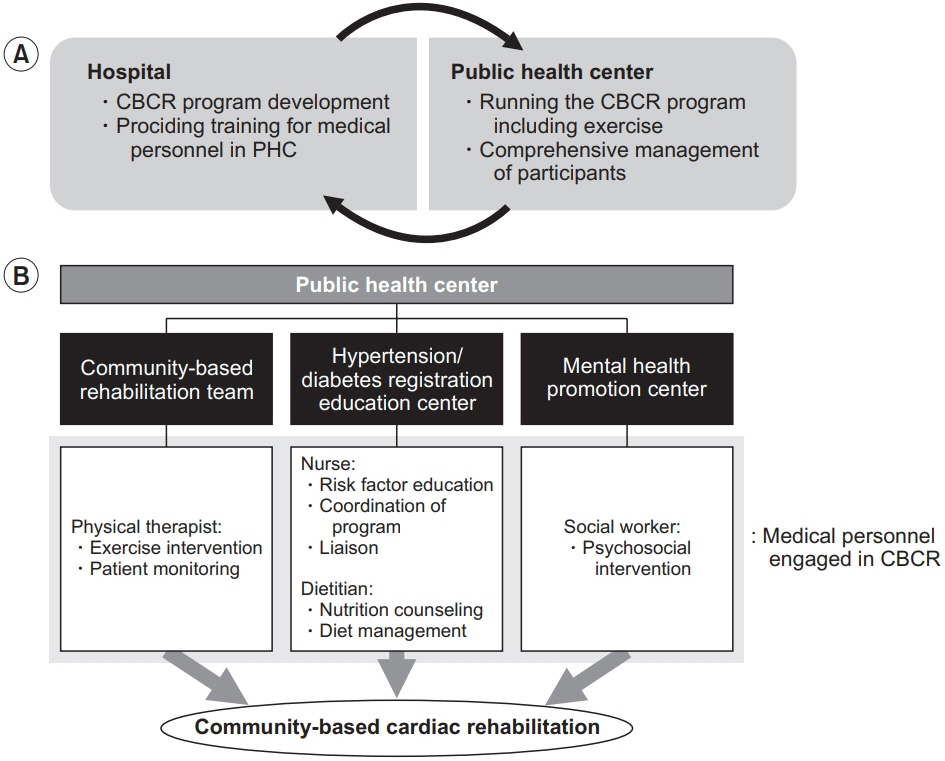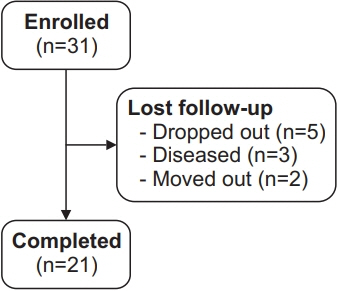Community-Based Cardiac Rehabilitation Conducted in a Public Health Center in South Korea: A Preliminary Study
- Affiliations
-
- 1Kangwon Regional Cardiocerebrovascular Center, Kangwon National University Hospital, Chuncheon, Korea
- 2Department of Rehabilitation Medicine, Kangwon National University Hospital, Chuncheon, Korea
- 3Department of Rehabilitation Medicine, Kangwon National University School of Medicine, Chuncheon, Korea
- 4Division of Public Health, Kangwon National University Hospital, Chuncheon, Korea
- 5Hongcheon County Hypertension and Diabetes Registration and Education Center, Hongcheon-gun, Korea
- 6Hongcheon Public Health Center, Hongcheon-gun, Korea
- KMID: 2510815
- DOI: http://doi.org/10.5535/arm.20084
Abstract
Objective
To evaluate the safety and effectiveness of the community-based cardiac rehabilitation (CBCR) program that we had developed.
Methods
Individuals aged >40 years with cardiovascular disease or its risk factors who were residing in a rural area were recruited as study subjects. The CBCR program, which consisted of 10 education sessions and 20 weeks of customized exercises (twice a week), was conducted in a public health center for 22 weeks. Comprehensive outcomes including body weight, blood glucose level, and 6-minute walk distance (6MWD) were measured at baseline, 11th week, and completion. Furthermore, the outcomes of young-old (65–74 years) and old-old (≥75 years) female subjects were compared.
Results
Of 31 subjects, 21 completed the program (completion rate, 67.7%). No adverse events were observed, and none of the subjects discontinued the exercise program because of chest pain, dyspnea, and increased blood pressure. Body weight and blood glucose level were significantly decreased, and 6MWD was significantly increased following program implementation (p<0.05). Both young-old and old-old women exhibited an improvement in blood glucose level and 6MWD test (p<0.05).
Conclusion
We reported the results of the first attempted CBCR in South Korea that was implemented without adverse events during the entire program. Improved aerobic exercise ability and reduced risk factors in all participants were observed. These improvements were also achieved by older adults aged ≥75 years.
Figure
Cited by 4 articles
-
Do Patients Maintain Proper Long-Term Cardiopulmonary Fitness Levels After Cardiac Rehabilitation? A Retrospective Study Using Medical Records
Chul Kim, Hee Eun Choi, Jin Hyuk Jang, Jun Hyeong Song, Byung-Ok Kim
Ann Rehabil Med. 2021;45(2):150-159. doi: 10.5535/arm.20123.Community-Based Aerobic Exercise Program for Primary Prevention of Cardiovascular Disease in Adults With Visual or Auditory Impairments: A Feasibility Study
Sora Baek, Yuncheol Ha, Jaemin Mok, Haekyung Lee, Woojoo Song
Ann Rehabil Med. 2021;45(3):204-214. doi: 10.5535/arm.20220.Evaluation of Current Resources Available for Community-Based Cardiac Rehabilitation in Korea: A Nationwide Survey Study
Chul Kim, Jidong Sung, Jae-Young Han, Sungju Jee, Jang Woo Lee, Jong Hwa Lee, Won-Seok Kim, Heui Je Bang, Sora Baek, Kyung Lim Joa, Ae Ryoung Kim, So Young Lee, Jihee Kim, Chung Reen Kim, Oh Pum Kwon
J Korean Med Sci. 2022;37(14):e109. doi: 10.3346/jkms.2022.37.e109.Fact Sheet on Cardiac Rehabilitation for Cardiovascular Disease in South Korea
Ki-Hong Kim, Jae-Young Han
Ann Rehabil Med. 2023;47(5):318-325. doi: 10.5535/arm.23050.
Reference
-
1. Perk J, De Backer G, Gohlke H, Graham I, Reiner Z, Verschuren WM, et al. European guidelines on cardiovascular disease prevention in clinical practice (version 2012): the fifth joint task force of the European society of cardiology and other societies on cardiovascular disease prevention in clinical practice (constituted by representatives of nine societies and by invited experts). Int J Behav Med. 2012; 19:403–88.2. Balady GJ, Williams MA, Ades PA, Bittner V, Comoss P, Foody JM, et al. Core components of cardiac rehabilitation/secondary prevention programs: 2007 update. Circulation. 2007; 115:2675–82.
Article3. Anderson L, Oldridge N, Thompson DR, Zwisler AD, Rees K, Martin N, et al. Exercise-based cardiac rehabilitation for coronary heart disease: Cochrane systematic review and meta-analysis. J Am Coll Cardiol. 2016; 67:1–12.4. Kim C, Sung J, Lee JH, Kim WS, Lee GJ, Jee S, et al. Clinical practice guideline for cardiac rehabilitation in Korea. Ann Rehabil Med. 2019; 43:355–443.
Article5. Neubeck L, Freedman SB, Clark AM, Briffa T, Bauman A, Redfern J. Participating in cardiac rehabilitation: a systematic review and meta-synthesis of qualitative data. Eur J Prev Cardiol. 2012; 19:494–503.
Article6. Im HW, Baek S, Jee S, Ahn JM, Park MW, Kim WS. Barriers to outpatient hospital-based cardiac rehabilitation in Korean patients with acute coronary syndrome. Ann Rehabil Med. 2018; 42:154–65.
Article7. Angelis CD, Bunker S, Schoo A. Exploring the barriers and enablers to attendance at rural cardiac rehabilitation programs. Aust J Rural Health. 2008; 16:137–42.
Article8. Ghisi GLM, Pesah E, Turk-Adawi K, Supervia M, Jimenez FL, Grace SL. Cardiac rehabilitation models around the globe. J Clin Med. 2018; 7:260.9. Ministry of Health and Welfare. Health and welfare statistical yearbook 2018. Sejong, Korea: Ministry of Health and Welfare;2018.10. American College of Sports Medicine. ACSM’s guideline for exercise testing and prescription. 10th ed. Philadelphia, PA: Wolters Kluwer;2018.11. American College of Sports Medicine. ACSM’s guideline for exercise testing and prescription. 9th ed. Philadelphia, PA: Lippincott Williams & Wilkins;2013.12. Sung J, On YK, Kim HS, Chae IH, Sohn DW, Oh BH, et al. Development of Korean Activity Scale/Index (KASI). Korean Circ J. 2000; 30:1004–9.
Article13. Oh JY, Yang YJ, Kim BS, Kang JH. Validity and reliability of Korean version of International Physical Activity Questionnaire (IPAQ) short form. J Korean Acad Fam Med. 2007; 28:532–41.14. Kim MH, Cho YS, Uhm WS, Kim S, Bae SC. Crosscultural adaptation and validation of the Korean version of the EQ-5D in patients with rheumatic diseases. Qual Life Res. 2005; 14:1401–6.
Article15. Lee YK, Nam HS, Chuang LH, Kim KY, Yang HK, Kwon IS, et al. South Korean time trade-off values for EQ-5D health states: modeling with observed values for 101 health states. Value Health. 2009; 12:1187–93.
Article16. ATS Committee on Proficiency Standards for Clinical Pulmonary Function Laboratories. ATS statement: guidelines for the six-minute walk test. Am J Respir Crit Care Med. 2002; 166:111–7.17. Ross RM, Murthy JN, Wollak ID, Jackson AS. The six minute walk test accurately estimates mean peak oxygen uptake. BMC Pulm Med. 2010; 10:31.
Article18. Richardson G, van Woerden HC, Morgan L, Edwards R, Harries M, Hancock E, et al. Healthy hearts: a community-based primary prevention programme to reduce coronary heart disease. BMC Cardiovasc Disord. 2008; 8:18.
Article19. Kubilius R, Jasiukeviciene L, Grizas V, Kubilienė L, Jakubseviciene E, Vasiliauskas D. The impact of complex cardiac rehabilitation on manifestation of risk factors in patients with coronary heart disease. Medicina (Kaunas). 2012; 48:166–73.
Article20. Mosleh SM, Bond CM, Lee AJ, Kiger A, Campbell NC. Effects of community based cardiac rehabilitation: comparison with a hospital-based programme. Eur J Cardiovasc Nurs. 2015; 14:108–16.
Article21. Zhang L, Zhang L, Wang J, Ding F, Zhang S. Community health service center-based cardiac rehabilitation in patients with coronary heart disease: a prospective study. BMC Health Serv Res. 2017; 17:128.
Article22. Mandic S, Body D, Barclay L, Walker R, Nye ER, Grace SL, et al. Community-based cardiac rehabilitation maintenance programs: use and effects. Heart Lung Circ. 2015; 24:710–8.
Article23. Hutchinson K. Community-based cardiac rehabilitation: a YMCA model. ACSMs Health Fit J. 2006; 10:21–7.24. Mandic S, Hodge C, Stevens E, Walker R, Nye ER, Body D, et al. Effects of community-based cardiac rehabilitation on body composition and physical function in individuals with stable coronary artery disease: 1.6- year followup. Biomed Res Int. 2013; 2013:903604.25. Clark AM, Munday C, McLaughlin D, Catto S, McLaren A, Macintyre PD. Peer support to promote physical activity after completion of centre-based cardiac rehabilitation: evaluation of access and effects. Eur J Cardiovasc Nurs. 2012; 11:388–95.
Article26. Korean Statistical Information Service. Estimated population by age group (production age population, elderly population) [Internet]. Daejeon, Korea: Korean Statistical Information Service;2019. [cited 2020 Oct 30]. Available from: https://kosis.kr/statisticsList/statisticsListIndex.do?menuId=M_01_01&vwcd=MT_ZTITLE&parmTabId=M_01_01#SelectStatsBoxDiv.27. Korean Statistical Information Service. Ratio of the elderly population (metropolitan-city or province/city/gun/gu). Daejeon, Korea: Korean Statistical Information Service;2020. [cited 2020 Oct 30]. Available from: https://kosis.kr/statHtml/statHtml.do?orgId=101&tblId=DT_1YL20631.28. Kim C, Choi I, Cho S, Han JY, Kim AR, Kim WS, et al. Cardiac rehabilitation and 5-year mortality after acute myocardial infarction: report from 11 tertiary hospitals in Korea (ETHIK Study). Eur J Phys Rehabil Med. 2020; 56:489–95.
Article29. Kim KH, Jang YC, Song MK, Park HK, Choi IS, Han JY. Changes in aerobic capacity over time in elderly patients with acute myocardial infarction during cardiac rehabilitation. Ann Rehabil Med. 2020; 44:77–84.
Article30. Pasquali SK, Alexander KP, Peterson ED. Cardiac rehabilitation in the elderly. Am Heart J. 2001; 142:748–55.
Article31. Marchionni N, Fattirolli F, Fumagalli S, Oldridge N, Lungo FD, Morosi L, et al. Improved exercise tolerance and quality of life with cardiac rehabilitation of older patients after myocardial infarction: results of a randomized, controlled trial. Circulation. 2003; 107:2201–6.
Article32. Baldasseroni S, Pratesi A, Francini S, Pallante R, Barucci R, Orso F, et al. Cardiac rehabilitation in very old adults: effect of baseline functional capacity on treatment effectiveness. J Am Geriatr Soc. 2016; 64:1640–5.
Article33. Bakhshayeh S, Sarbaz M, Kimiafar K, Vakilian F, Eslami S. Barriers to participation in center-based cardiac rehabilitation programs and patients’ attitude toward home-based cardiac rehabilitation programs. Physiother Theory Pract. 2019; 1–11.
Article
- Full Text Links
- Actions
-
Cited
- CITED
-
- Close
- Share
- Similar articles
-
- A Study on the Factors in Relation to Job Performance of Community-Based Rehabilitation Program in Health Centers
- The role and responsibility of community health practitioner based on the rural community development and the reform of health care system
- Cardiac Rehabilitation in Patients with Coronary Artery Disease
- Evaluation of Current Resources Available for Community-Based Cardiac Rehabilitation in Korea: A Nationwide Survey Study
- Is the Legal Basis for Physical Therapist’s Home-Based Rehabilitation Appropriately Prepared?





